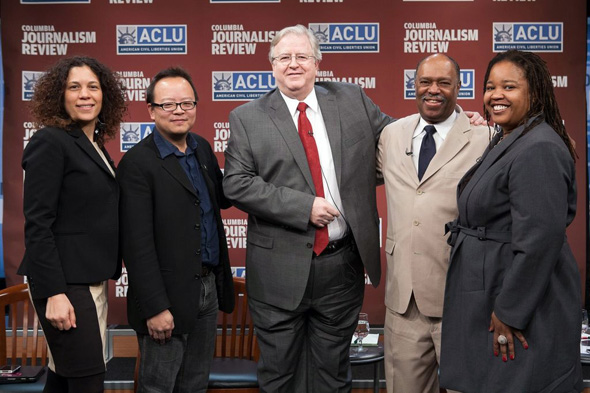
Wise wordsFrom left, Raquel Cepeda, Jeff Yang, Gene Policinski, and Richard Prince fielded questions from moderator Farai Chideya.
For our March-April issue, CJR asked 18 journalists to answer a question: “How can we improve coverage of race, class, and social mobility?” On April 3, with support from the American Civil Liberties Union, we convened a panel discussion at the Newseum in Washington, DC, to explore the challenges and implications of reporting on these three topics–“core issues that deal with the heart of American opportunity and democracy,” according to ACLU executive director Anthony Romero.
“This is not anything we’re going to puzzle through easily,” said moderator Farai Chideya, author of The Color of Our Future and a Distinguished Writer in Residence at New York University’s Arthur L. Carter Journalism Institute. “We got here after many years of struggling with American identity, race, and class. And we’re going to keep pushing.” What follows are highlights from that discussion, and points where CJR’s panelists pushed particularly hard. To watch the full panel, go to C-SPAN.
‘Majority minority’ nations and newsrooms
“Somewhere between 2043 and 2050 . . . we will have a ‘majority minority’ society, in which no single racial group is more than 50 percent” of the overall population, said Gene Policinski, executive director of the Freedom Forum’s First Amendment Center. “We’re moving toward a diverse society in a way this country has never seen.”
But newsrooms may not share the same trajectory. A study released in 2012 by the American Society of Newspaper Editors found that, while print and online newsroom employment fell by 2.4 percent last year, job loss for minorities in newsrooms was 5.7 percent.
One such “minority majority” city is Philadelphia, where the combined black and Hispanic populations are greater than the white population, and where roughly one in four people is below the poverty level. In February, Philadelphia Magazine published “Being White in Philly,” a plaintive feature that generated more than 6,000 comments, many of them angry, and heated discussion among our panelists.
“It raised some of the issues we’re talking about, including the fact that the media in Philadelphia, in particular print media, were not very diverse,” said Richard Prince, a columnist at the Maynard Institute for Journalism Education. “Philadelphia Magazine itself had no African-Americans on its editorial staff.”
While its demographics may not precisely reflect those of its city, a media organization should seek out the expertise necessary to cover a diverse community. “There’s education going on every time somebody with a different perspective is in your newsroom,” said Policinski.

Question time Thanks for your comments! At top right, CJR’s Stephanie Sandberg and Cyndi Stivers flank the ACLU’s Anthony Romero.
The pitfalls of political language
The day before CJR’s panel, the Associated Press announced that its stylebook would no longer recommend use of “illegal immigrant”–a term previously applied to a person rather than to a person’s behavior. “Every time I see the term ‘illegal immigrant,’ I think to myself, ‘I’m sure Native Americans have a very different perspective on what ‘illegal immigrant’ means,” said Jeff Yang, “Tao Jones” columnist for The Wall Street Journal online.
“Language is political,” said Prince. “We see the same thing going on with ‘pro-life’ versus ‘pro-choice,’ ‘affirmative action’ versus ‘racial preferences,’ ‘same-sex marriage’ versus ‘gay marriage.’ For the Associated Press to decide that being ‘illegal’ is not the first thing you should know about someone . . . is an achievement.”
Making a business case for diversifying newsrooms
Raquel Cepeda, a documentary filmmaker and author of Bird of Paradise: How I Became Latina, said she was “often the only person of color” on documentary-film panels and noted that she’d struggled to place sections of her book in mainstream media outlets. Chideya recalled letting an African-American college grad stay with her for six months so she could afford to take an unpaid internship.
“That was my way of giving back to my own community–and I don’t mean the black community, I mean the journalism community,” said Chideya. “Because the journalism community deserves diversity.”
As media organizations report on an increasingly mixed populace, Policinski suggested, those diverse communities might just help those newsrooms survive. “There’s an economic argument to be made here, I think,” he said.
At the same time, journalists of color shouldn’t be expected to cover only their own communities, or to speak on behalf of everyone of their race (and yes, both of these things happen too often). “Because you’re from a certain race, you’re expected to be an expert on that race,” Yang said wryly, to the agreement of the other panelists.
“I don’t think that we can survive as an industry if we try to say that the only way people can cover a story is if they have a certain background from which to speak,” Yang concluded. “That’s antithetical to what journalism is about. Journalism is about telling stories that matter to a broad array of people, not purely to one-to-one, customized perspectives.”
Brendan Fitzgerald is senior editor of CJR.
